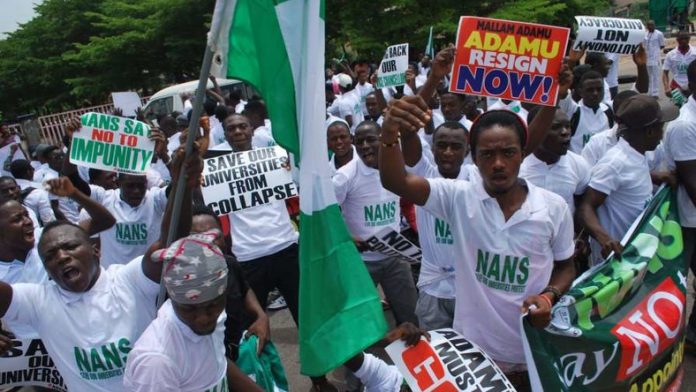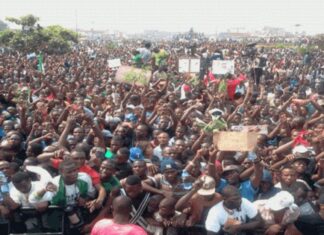In the last days of 2018, leadership of the National Association of Nigerian Students (NANA) issues a 14-day ultimatum to the Academic Staff Union of Universities (ASUU) and the Federal Government, calling for an end of the ASUU strike. And in the first week of the year, the NANS president, Danielson Akpan, led executive committee members of the association on a visit to President Muhammadu Buhari, where he assured Buhari that NANS could deliver 20 million votes for him at the 16 February election.
This series of events led to a flurry of discussions on how the students movement found itself at this sorry state and of cause the question of “what is to be done?” Several former students’ leaders condemned the NANS leadership. One of these, Abdulmahmud Aminu who was NANS president in the 1991/92 session asked for his name to be expunged from the annals of NANS.
More important than any emotive expression by people outside the studentry was the rebuttal of the NANS stance by the Alliance of Nigerian Students Against Neoliberal Attacks (ANSA). It stressed the historical ties between the students movement and the university teachers, pointing out that the struggle being waged by ASUU for improved funding of the education system should have been led by NANS.
It is not for us to laugh or to cry. Understanding the dynamics behind the degeneration of the students movement and fanning the embers of resistance within its ashes which ANSA represents are both important for a revival of the students movement as a stronghold of radical and revolutionary politics.
NANS was formed in June 1990 by radical patriotic and revolutionary youths, as leaders and activists of students’ unions across the country. This was to fill the gap created with the banning of the National Union of Nigerian Students (NUNS) by General Olusegun Obasanjo-led military junta, two years earlier. Fifteen years later, it was split – by radical patriotic and revolutionary youths. But, little did they know at the time that they were laying the foundations for perdition.
What led to such a drastic decline of collaboration along with contention by rival forces on the left in the students’ movement? A movement that had led struggles on the streets against military dictatorship, increases in the pump prices of petroleum products and the structural adjustment programme (SAP) does not mechanically implode.
The objective context included the collapse of the Soviet Union empire at the beginning of the 1990s and splits in socialist groups and mass democratic coalitions like the Campaign for Democracy. The former led to the collapse of Marxist-Leninist groups comprising the Patriotic Youth Movement (PYMN) and their more traditional fronts on campuses (these were replaced, where they were, with NGOs which had become the terrain of M-L work outside the campuses as well). While the contributed to a curious pattern of alliances on the eve of the split.
In the period leading to the split the active socialist groups on campuses were mainly of Trotskyist traditions. With the earliest of these being less than a decade old at the time, they lacked the national Marxist-Leninist groups had grown over decades, from the NUNS days.
Meanwhile, the state took up infiltration with renewed vigour. In December 1991, the NANS Senate had expelled Faith Osadolor a vice-president, Chima Okereke general secretary and Bola Ajimuda senate president. They were all renowned activists to students. But it turned out that they were no less renowned to the state as spies. A few years later, the state became more systematic, establishing a Directorate for Students Intervention, which included quite a few liberal-democratic NANS leaders.
The major subjective factor for the split was rivalry for control of the NANS structures by different tendencies, which was pursued by some in the most unprincipled manner. There were three acts before the curtains on a united NANS body in 1995. Each was acted on the stage of a NANS convention.
The first of these was on 1 December 1990. The Trotskyist left presented a challenge to the Marxist-Leninist candidacy. Whilst it was likely that the Labour Militant’s Adeola Soetan, who was the OAU Ile-Ife president would still have lost to the Abdulmahmud Aminu, the PYMN candidate from UniJos, it was clear that there were quite a few fake delegates – comrades who were recognised as representing schools they probably never visited in their lives.
The Trotskyist left, left the convention in protest. They had mainly two campuses in the walk out – OAU Ile Ife and UI.
The second act was at the January 1992a convention, in Calabar. This time around, there were more schools that felt robbed by PYMN. The Trotskyist-led campuses were joined by FUTA. A step beyond just a walkout was taken. The students’ unions of OAU Ife, Unilorin and FUTA constituted themselves as the NANS-Revolutionary Faction (NANS-RF). But this never functioned. That might have been significant loss of an avenue for experience in principled factional work within NANS.
The last act before the denouement of 1995 was the 7-8 May 1994 Convention at OAU Ife. About 78 unions were eventually accredited, as genuinely representing schools. This was more than double the number witnessed in most of the earlier conventions. They were largely mobilised down by the liberals. It was impossible for the PYMN to make any bureaucratic manoeuvres. And seeing an opportunity to oust PYMN dominance, the Trotskyist left struck an alliance with the liberals. Dennis Etim Inyang emerged as president.
PYMN cadres left the venue, with the capitation dues of N13,000 paid by unions. They headed to the press to declare NANS had been taken over by state agents, the dominant Marxist-Leninist groups in PYMN at the time were also the dominant groups in the Campaign for Democracy (CD).
Interestingly, since Naseer Kura, the NANS president was part of the group that broke away from CD (and formed the Democratic Alternative a month later), he challenged that narrative, on the instruction of his group. The CLO/DA trend had struck an alliance with the new NANS leadership which prevented the split from taking place in 1994.
What appeared to eventually trigger the split was the collaboration of NANS with the National Council of Women Societies to organise a Save Education Summit. After a botched Senate meeting scheduled for Sokoto on 10 June, an illegal “Senate meeting” was summoned by some unions loyal to the PYMN on 20 June 1995. There, the NEC was declared dissolved, a Caretaker Committee constituted, and “convention” fixed for 22 July at Ogun State University (no Olabisi Onabanjo University) Ago-Iwoye. The mainstream structure eventually held a Senate meeting on 7 July where it fixed 24-25 August for Convention.
For four years, the PYMN did its best to nurture the splinter NANS with a left orientation. It was more of a mixed bag with the mainstream body. After a sharp decline of ideological values under Baba Kazala who emerged in 1995, there appeared to be hope for rejuvenation with Moses Oisakhede elected as President on 6 December 1998. His death in a car crash on 1 September 1999 became a moment for sober reflection.
Attempts to unify the two factions were intensified. On 20 November a Unity Conference was held at Unilag which adopted the summoning of a unified senate meeting a few weeks later. The senate meeting fixed a unity convention for February 2000. This marked the end of any pretence at division along ideological lines. United or divided at different times, the NANS bureaucracy had become a pot of soup for lucre-seeking hangers on, many of whom spent almost all their lives as students or “stakeholders” to have a taste or continued access to the honeypot.
There were a few brilliant left moments, particularly at zonal levels specifically in Zone D. But this were few and far in-between. They couldn’t stop where NANS had degenerated to with Danielson. But, within this morass there arose in 2016 the Alliance of Students Against Neoliberal Attacks (ANSA). This started at OAU Ife and comprised cadres of the SWL, Education Rights Campaign and CWA. Within a short while, ERC pulled out. But ANSA has grown to have cadres in 31 campuses spread across three of the four NANS zones.
What are the lessons to draw from this convoluted history? First, the importance of left unity. This cannot be absolute. Inter-tendential conflicts should however be pursued on a principled basis. Second, all hope is not lost despite the huge disappointment of former students’ leaders with what NANS now is. ANSA holds great hope for a revival of the students’ movement and should be supported. Its cadreship equally has to be more creative with education, agitation and propaganda.
The question has arisen over NANS as a structure. Can it be reclaimed? Is there the need to establish a new national federation of students’ unions (which is what NANS is, really)?
We cannot build a house from its decking. The problem with the students’ movement has deep roots in the campuses. What is of the essence now is to reclaim the campuses. This is not just about running for “students’ union governments” offices. It is about strengthening (and in many campuses re/introducing) left movement traditions of meetings, with political and theoretical discussions, news and views boards and newspapers, in short re-building the left in the students’ movement, which is what the ANSA project is.
Where and when it becomes what could aspire to being an alternative to NANS as a students’ centre, that would be self-evident.
by Baba AYE









